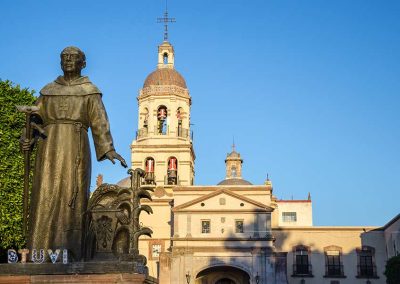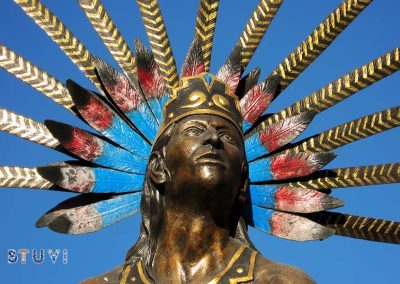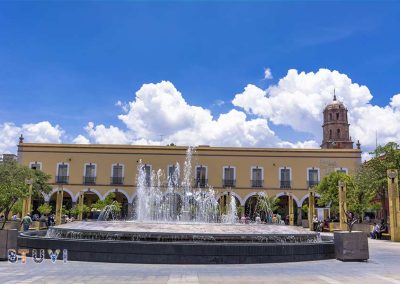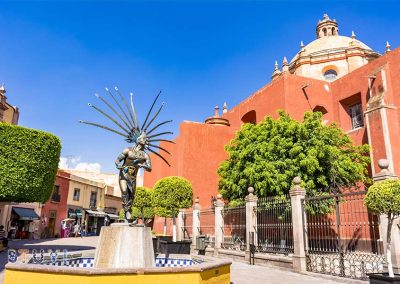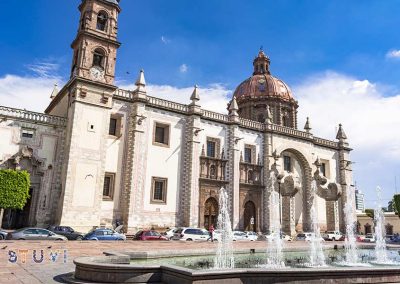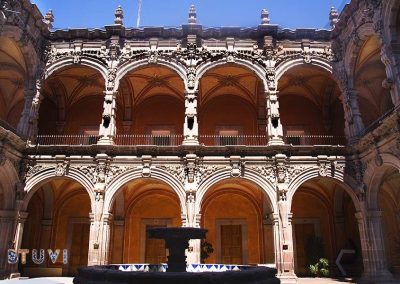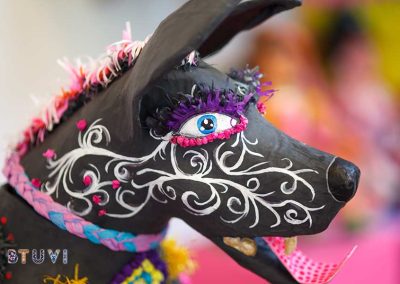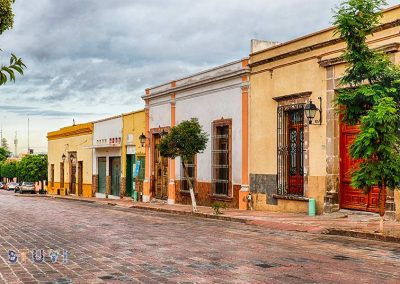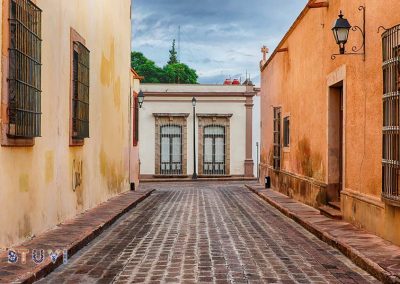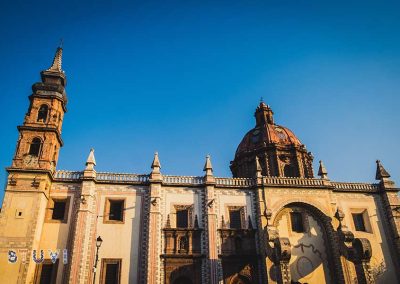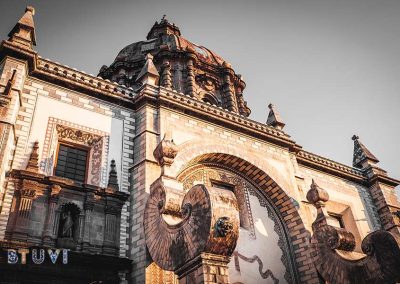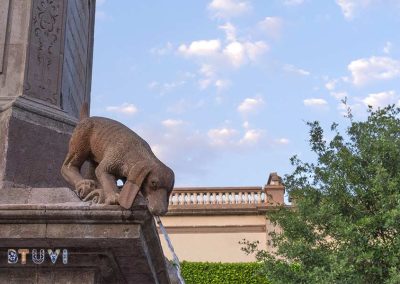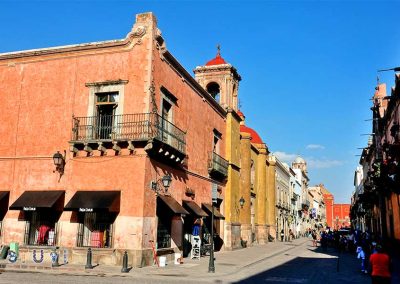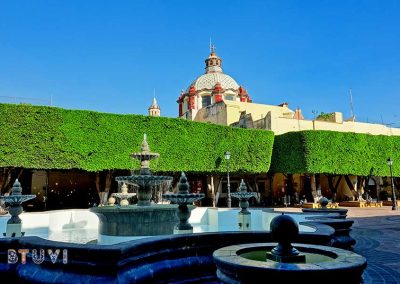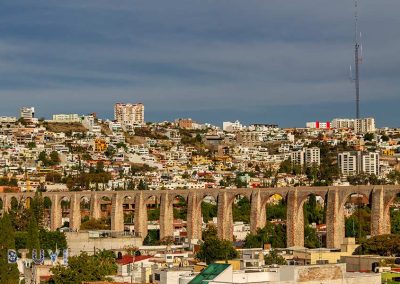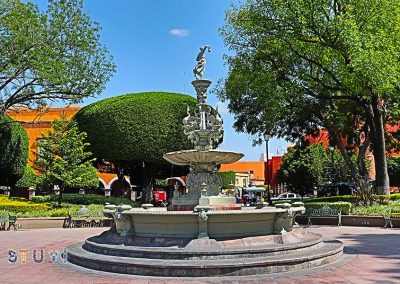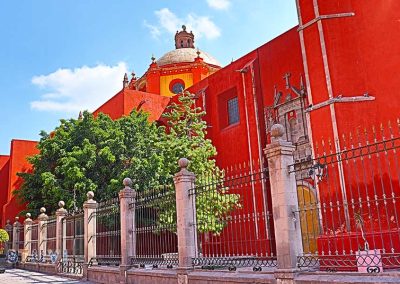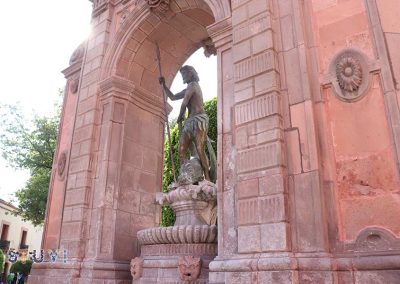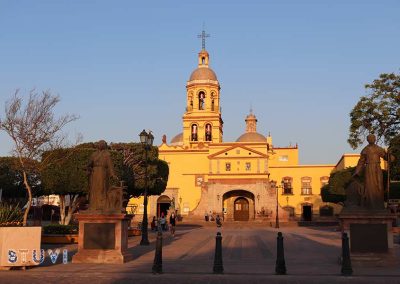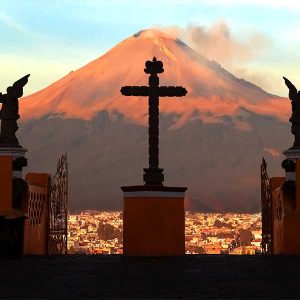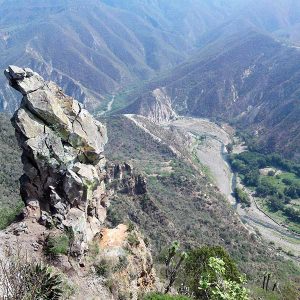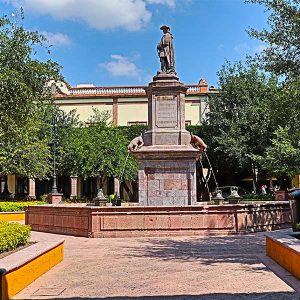(TE31) Queretaro
Tour and private guide
10 to 11 hours
All entrances
Private transportation
Pick up and drop off hotel
Tour brief description
Tour for 2 up to 15 people from Mexico City.
Entering this city is a whole experience that surprises and delights you. Its historic center has been recognized as human cultural heritage by the UNESCO. Walk its streets, see its beautiful squares and yards is taking a look to the civil and religious architecture of colonial baroque of Queretaro from XVI to XVIII centuries.
The city has a beautiful pink quarry aqueduct, beautiful colors and a great ambience from the center of Mexico, also has excellent art and history museums. There you can know more about the ancient pre-columbian population, the art of Queretaro inside the New Spain, the history of evangelism, the independence and the republic’s restoration.
This is a great destiny, where see is not everything, you have to listen the stories, anecdotes and artistic details told by our guides.
The unit price decreases according to the size of the group.
Departure Time
8:00 a.m.
Included
- Pick up and drop off in hotel.
- Visit to San Antonio de Padua temple.
- Visit to Corregidora yard.
- Visit to Zenea yard.
- Walk through 5 de Mayo and Libertad avenues.
- Visit to the murals of the house of la Corregidora.
- Visit to the façade Ecada house.
- Visit to Querétaro’s Plaza de Armas.
- Visit to the facade of Don Bartolo’s house.
- Visit to the temple of San Francisco de Asís.
- Visit to the fountain of Neptune.
- Visit to the temple of Santo Domingo.
- Visit to Guerrero yard.
- Visit to the temple of San Felipe Neri.
- Visit to the facade of the Republic Theater.
- Visit to the temple and ex – convent of Santa Cruz.
- Visit to the temple of Santa Rosa de Viterbo.
- Visit to the oriel and pantheon of illustrious Queretans.
- Entrance to the Conspirators Museum, to choose 1 of 6 (A, B, C, D, E, or F).
- Entrance to the Casa de la Zacatecana Museum, to choose 1 of 6 (A, B, C, D, E, or F).
- Entrance to the Regional Museum of Querétaro, to choose 1 of 6 (A, B, C, D, E, or F).
- Entrance to the Art Museum of Querétaro, to choose 1 of 6 (A, B, C, D, E, or F).
- Entrance to the Calendar Museum, to choose 1 of 6 (A, B, C, D, E, or F).
- Entrance to the City Museum and the Restoration Republic Museum (Capuchinas Temple), to choose 1 of 6 (A, B, C, D, E, or F).
- Driver.
- Private guide.
- Private transportation.
- Bottled wate r and snacks inside transportation.
- Souvenir.
- Face mask and sanitizing gel.
No Included
- Tips.
- Video and photography permits in museums, archaeological sites and attractions.
Languages
Spanish, English, German, French, Italian, Portuguese, Russian, Arabic, Japanese, Chinese and Korean.
Additional information
- It is essential to present ID to the guide before starting the tour.
- In this tour you have to chose one of the following museums and communicate the guide your choice.
- Tennis or comfortable shoes recommended.
- Sunglasses recommended.
- Sunblock and hat recommended.
- Your physical condition must let you walk from 120 to 180 minutes. (with breaks).
- Spanish and English explanations don’t have an extra cost.
- We don’t do surprise stops in any store to force you to buy handicrafts.
- We strictly respect the itinerary.
- We don’t sell you anything aboard or in the tour.
- Confirmation will be received by email at the time of booking.
- Infants under 2 years of age are free of charge, but must travel in the arms or on the legs of their parents. (please inform us in the notes).
- Babies (over two years old) and young children must have their own seats.
- A infant car seat available per tour, (please request it).
- The unit price decreases according to the size of the group.
(TE31) Queretaro
$338.71
USD max per person.
Final price in dollars includes all taxes
Itinerary
Temple of San Antonio de Padua
In the heart of the city, we start our trip in a beautiful public square to know a construction from the beginning of XVII century, with a simple façade and a superb interior because of its decorative art from that era, its neoclassical altarpieces and its paintings in walls and vaults.
Corregidora yard
Walking through streets and gadabouts, in a few minutes we’ll arrive to a beautiful garden, where in a pedestal of pink quarry there is the sculpture of the heroin of Mexico’s independence. To walk along this beautiful square will mean to be surrounded by little restaurants, Mexican snacks and beautiful stories.
Zenea yard
A few steps far away, there is very colorful and busy square garden that was constructed on mid XVI century and it has been transformed through the centuries until its current design from 1860. A sculpture of Greek goddess Hebe, a kiosk with a very Mexican ambience. If you come on Sunday, don’t surprise to see people dancing “danzón”, or if you come on December, you’ll see very luminous Christmas and new year ornaments.
5 de Mayo gadabout
When crossing the street we’ll find the 5 de Mayo gadabout, a must visit of the city. We’ll see, on the right side, the temple of San Francisco y we’ll be received by a beautiful sculpture of the chichimeca conchero dancer. In our walk we’ll watch historic buildings, snacks and handicrafts, and at the end, the Plaza de Armas or Plaza de los Perritos. It is a small gadabout, but its full of color, art and history of Mexico.
In this tour you have to chose one of the following museums and communicate the guide your choice.
A. Conspirator Museum
A house from XIX century, is a museum dedicated to the conspirations generated by the illustration ideas of breaking with the monarchical absolutism, ideas that were the base of Mexico’s independence and whole Latin America. Here you can see the conspiracy processes of France, United States and New Spain, exquisite murals and historic diagrams that show the seeds of Mexico’s independence.
B. Casa de la Zacatecana Museum
A property with a history and legend, a museum that is a house from XVII century, with 11 rooms that harbor a collection of decorative Mexican, European and oriental art, that goes from the viceregal era of XVI century to the beginning of XX century. Paints and sculptures, the most from the novo Hispanic period, bronze, ivory and terracotta sculptures, more than 35 English, American, French and German clocks from XVII, XVIII and XIX centuries.
This place is Querétaro is part of a legend from XIX century that cause in the atmosphere breath a mystery ambience, with a touch of richness, romance, treason and death, a place where you’ll be surprised by the objects and, at the same time, you’ll fell cold chills.
C. Regional Museum of Querétaro
Located in an ancient building that was a Franciscan viceregal convent in XVI century, we’ll find rooms and collections that show the artistic and historic richness of this region: pre Hispanic Mexico, the Indian towns, the New Spain, the independence, the republic and revolution.
It has a great pictorial and sculptural viceregal collection, also has archeological, ethnographic, colonial and contemporary pieces, ceramics, lithic, sculptures and paints. The maps and drawings of the environment and architecture of Querétaro will catch your attention. Also the diorama of a mine in the mountain range of Querétaro.
This enclosure presents great masters of novo Hispanic paint from XVII and XVIII centuries as its biggest treasures.
D. Art Museum of Querétaro
Its iconography and architecture are a beauty. There is a legend that say that the building sings. Maybe is for a perfectly carved in quarry angels chorus, that can be observed from the central courtyard next to a beautiful fountain, two level arcades and infinite baroque details carved in pillars from XVIII century.
Its 10 rooms contain mannerist, baroque and neoclassical works. Apart from modern art donations from XVIII and XIX centuries, this museum has a very relaxing and quiet atmosphere.
E. Calendar Museum
A big house from XVIII century houses the first calendar museum in the world. In its rooms, there is a beautiful collection of old calendars where you can see original contemporary art paints that show, from the artists view, the Mexican moods, habits, legends and worldview.
Here there is art with different themes in postal stamps, litographs and engravings from the years 30 to 60 of XX century. The sun stone, popularly known as Aztec Calendar, here we see varved in wood and in its real size. In this place the rooms stand out, also the time and space, the origin of the calendar, the sun stone, the calendar in Mexico and the art in calendar from 1890 to 2011.
F. Capuchinas Ex Convent
An edifice from the middle of XVIII century, that houses two museums: City’s and Republic Restoration. The structure distinguish for its sobriety and plain beauty. In the principal yard there is a lovely water sack, arcades with crossed yards and a hallways and rooms with a mystery vibe.
The city museum receives its visitors with the sculpture of the poet and his cat. Meanwhile, inside you can see contemporary Mexican and foreign art, pictorial and sculptural exhibitions and endless cultural and artistic expressions.
The Republic Restoration Museum is about the historical events of the war with France, the triumph of Mexico and the republican liberals over the imposed empire and the Mexican conservatives. Also, there are the prisoner emperor and defeated generals rooms in the round-up of Querétaro in 1867.
Here are shown the most relevant events between president Benito Juárez, winner, and Maximiliano de Habsburgo, loser. You’ll listen a touching narration of the final days of the emperor before his shooting, a personage that people said was Mexican, not by birth but by death. Definitely, a museum full of Mexican history from the second half of XX century.
Corregidora House
A sober and robust house from XVIII century, where there were conspirators reunions and historic events for Mexico’s independence, and today holds state government offices. There, we can see in the main yard, a mural that resumes the history of Mexico.
Ecala House
In front of Plaza de los Perritos, we’ll see the façade of a house with a master quarry and tile work, where the archery, fine ironwork balconies and an infinity of details stand out.
Querétaros’s Plaza de Armas
Also know as Plaza de los Perritos, is a space from XVIII century surrounded by splendorous viceregal buildings and an octagonal quarry fountain with a pedestal with four puppies, one on each corner. On top there is a statue dedicated to the benefactor of the city’s aqueduct.
Libertad Gadabout
Parallel to 5 de Mayo Gadabout, a place full of art, colors and memories, with little galleries, and sometimes, full of roadside stands, where you can buy local handicrafts.
Temple of San Francisco de Asís
Ex-cathedral of the city that was built in the first half of XVIII century. With a sober façade of baroque style quarry, a beautiful outside high relief of a scene of apostle Santiago, a monumental three parts tower with baroque style ornamentation, and inside, lateral neoclassic altars.
Neptune Fountain
At his right side his trident, and at his left side, the tail of one of the two big fishes that slip between his feet. A fountain considered a piece of art, made in 1797 in neoclassical style. We can see it in one of the most remarkable crossings of this beautiful city.
Temple and ex convent of Santo Domingo
Raised at the end of XVII century. It was used as hospice and frays hospital who evangelized the zone. The structure has a quarry façade baroque style, very simple, in which are columns and an entrance door. Also, you can admire its wooded ornaments in neoclassical style.
Guerrero Yard
The next parade in our way to the cathedral is a little and old garden with aesthetically pruned trees that surround a beautiful fountain. A must place for the peculiarity of its design.
Temple of San Felipe Neri
This is the cathedral of Querétaro that dates from the beginning of XIX century. Originally was a temple and was one of the last works from the viceroyalty. Its façade contains a wide variety of carved details with baroque and neoclassical styles, red tezontle in its portrait and columns with pink quarry ornaments, in addition of an interior with sculptures and paints.
Republic Theater
A neoclassical building with a façade with three arcs in a corner and two vertical bands that harbor four niches that represent the wisdom, justice, equality and fraternity. The stories you will listen in this enclosure are related with the first time the Mexican national anthem was played, the death warrant for Maximiliano de Habsburgo, archduke of Austria and the promulgation of the current constitution of Mexico.
Temple and convent of Santa Cruz
A construction from XVI century with a few modifications until XIX century. From a beautiful square it can been seen a sober façade with a triangular finial. Inside, you can see pink quarry altarpieces, some baroque, some neoclassical, and even back, the holy cross carved in stoned. However, it has a secret attraction: in the convent garden lives a strange tree with cross form thorns. It is worth being surprised.
Temple of Santa Rosa de Viterbo
Considered the biggest expression of Queretan baroque. With a solemn façade, all the construction is a piece of art that dates from XVII century. Its bell tower has the first three faces clock assembled in American continent. Inside there is an organ from XVIII century and five fine wooded art altarpieces with a dazzling gold layer and a pulpit with fine woods scales, silver, ivory and tortoiseshell. Currently, only a building like this can houses the Queretan Culture and Arts Institute.
Oriel and Pantheon of Illustrious Queretans
Our final parade will be in the oriel and pantheon. Two areas separated by a crossroad that can be visited at the same time. The oriel offers a wonderful view of the city and the famous pink quarry aqueduct, an icon of the city.
The small and precious Pantheon of Illustrious Queretans is the first civil pantheon of the city, and was created in 1847. There rest a lot of important persons of Querétaro: independence heroes, founders and benefactors.
We’ll end the travel, going back to your hotel.


